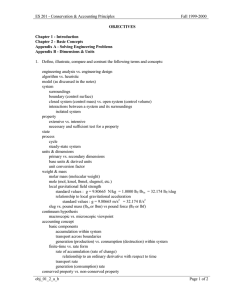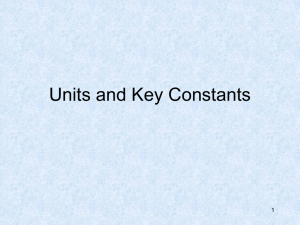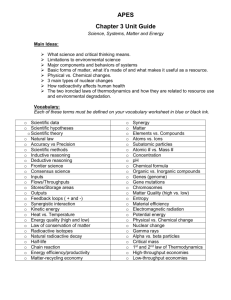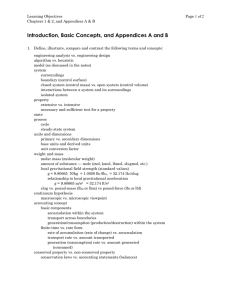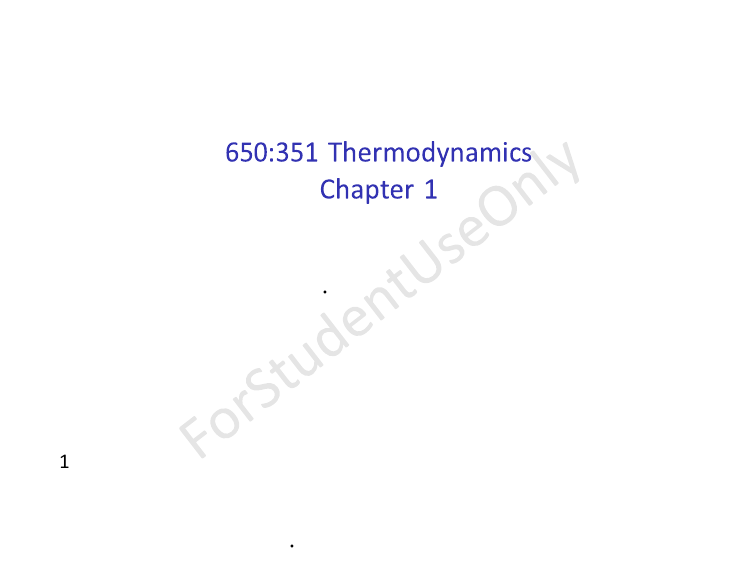
· 1 · Overview of Course • Conservation of mass • Conservation of momentum • Conservation of energy • Laws of Thermodynamics (includes Conservation of Energy) • Equation of state • Property tables and charts 2 Problems in this course are solved using the above Conservation of Mass • Empedocles (c. 490 - 430 BC) For it is impossible for anything to come to be from what is not, and it cannot be brought about or heard of that what is should be utterly destroyed. • A similar concept was expressed by the Persian Muslim scholar Nasr al-Dn Tus (5 Esfand 579 11 Tir 653)1 A body of matter cannot disappear completely. It only changes its form, condition, composition, color and other properties and turns into a di erent complex or elementary matter. 124 February 1201 to 2 July 1274 (Gregorian calendar) Conservation of Momentum • Pur Sna (1 Shahrivar 359 31 Khordad 416) 2 4 The Persian polymath3 proposed that the motion of a projectile was the consequence of an impulse imparted to the projectile by the thrower, and that such motion would not cease in a vacuum, but would be dissipated by external forces such as air resistance 222 August 980 to 21 June 1037 known as Ibn Sna. The Latinized version of the name is Avicenna. He was the author of 450 works, including 150 on philosophy and 40 on medicine. He is a central character in the historical novel The Physician, by Noah Gordon, published in 1986 and later adapted for a screenplay premiered in 2013. The r le of Pur Sna was portrayed by Sir Ben Kingsley. 3Also Conservation of Momentum • Isaac Newton (1642 - 1727) Proposed three fundamental laws of mechanics in Philosophi Naturalis Principia Mathematica (Mathematical Principles of Natural Philosophy) First Law (the Law of Inertia): In the absence of a net external force, an object at rest remains at rest and an object in uniform motion remains in uniform motion as observed in an inertial frame of reference 6 Second Law (the Conservation of Momentum): The time rate of change of momentum of an object (de ned as the product of its mass and velocity as viewed in an inertial frame of reference) is equal to the net external force on the object Third Law (the Law of Reactions: The force of object A on object B is equal and opposite to the force of object B on object A Conservation of Energy (First Law of Thermodynamics) • Gottfried Wilhelm von Leibniz (1646-1716) Proposed the concept of conservation of mechanical energy. Given a system of n individual masses mi each with speed ci, a quantity denoted V vis viva (living force) was conserved V = Pii==n1mici2. This is now recognized as twice the mechanical energy of the system. • James Prescott Joule (1818-1889) Proposed the mechanical equivalent of heat in a series of experiments 8 • Hermann von Helmholtz (1821-1894) Pstulated a uni ed concept of conservation of energy in the framework of mechanics, heat, light, electricity, and magnetism (First Law of Thermodynamics) Second Law of Thermodynamics • Nicolas LØonard Sadi Carnot (1796-1832) 9 Presented the theory of the maximum e ciency of heat engines later known as the Carnot cycle1 • Rudolf Clausius (1822-1888) First postulated the basic concept of the Second Law of Thermodynamics in 1850. In 1854 he summarized the concept by stating Heat can never pass from a colder to a warmer body without some other change, connected therewith, occurring at the same time 1 In modern terms, it states that the maximum rate of conversion of heat Q to work W H due to an engine operating reversibly (quasi-statically) between two in nite heat reservoirs with temperatures TH and Tc (TH > TC) is W/QH = (TH − TC)/TH. 10 Second Law of Thermodynamics • Lord Kelvin (William Thompson, 1824-1907) Postulated an equivalent statement: It is impossible, by means of inanimate material agency, to derive mechanical e ect from any portion of matter by cooling it below the temperature of the coldest of the surrounding objects • Max Planck (1858-1947) O ered an equivalent statement of the Second Law as It is impossible to construct an engine which will work in a complete cycle, and 11 produce no e ect except the raising of a weight and cooling of a heat reservoir 12 Fundamental Units • All physical processes involve units • The fundamental units in the SI system are Dimension Unit Length meter (m) Mass kilogram (kg) Time second (s) Temperature kelvin (K) Electric current ampere (A) Amount of light candela (cd) Amount of matter mole (mol) • The fundamental units in the English system are 13 Fundamental Units Dimension Unit Length Mass Time Temperature Electric current foot (ft) slug (slug) second (s) rankine (R) ampere (A) • The fundamental units can be converted between English and SI 1 foot 1 slug 1 deg R = = = 0.3048 meters 14.5939029 kilograms 0.55556 deg K • Derived units 14 Fundamental Units Unit English SI Force Energy Power pound force (lbf) British Thermal Unit (BTU) Horsepower (HP) Newton (Nt) Joule (J) Watt (W) • Derived units can be converted between English and SI 1 lbf = 4.44822162 Nt 1 BTU = 1055.05585 J 1 HP = 745.699872 W • What is pound mass (lbm) ? One lbm is the amount of mass that weighs one lbf on earth • Since weight is the force of gravity on an object 15 Fundamental Units weight = 1 lbf = 1 · slug·ft/s2 = 1 lbm · gravity 1 lbm · 32.17 ft/s2 1 lbm · 32.17 ft/s2 and therefore . • The di erences between lbm and lbf and slug are important • Failure to understand the di erences can lead to an error of nearly two orders of magnitude and thus ... 16 Fundamental Units • The di erences between lbm and lbf and slug are important • Failure to understand the di erences can lead to an error of nearly two orders of magnitude and thus ... 17 Fundamental Units 18 Systems and Control Volumes • A system is a quantity of matter or region of space • A closed system comprises a xed amount of mass • An open system is a properly selected region of space 19 Closed system Closed system Open system moving boundary State and Equilibrium • Thermodynamics deals with equilibrium states • An equilibrium state represents a condition wherein there are no unbalanced forces or potentials in the system • Thermal equilibrium implies that the temperature is the same throughout the system • Mechanical equilibrium implies that the net forces and moments on the system are zero 20 • Phase equilibrium implies that the mass of each phase (e.g., solid, liquid and gas) remains constant • Chemical equilibrium implies that the chemical composition of the system remains constant State Postulate • Once a su cient number of properties of a system are speci ed, the remaining properties can be determined • As an example, consider the ideal gas equation pV = nRT 21 For a given volume V, knowing the pressure p, and temperature T is su cient to determine2 the number of moles n • The State Postulate The state of a simple compressible system is completely speci ed by two independent, intensive properties Processes and Cycles • The change of a system from one state to another is a process 2 R = 8.31447 kJ/kmole·K is the Universal Gas Constant 22 • The series of states through which a system passes from its initial to nal state is the path • The path may be quasi-equilibrium or non-equilibrium Processes p−V diagram 23 Steady Flow Processes • During a steady ow process, the ow variables at a xed location do not change in time; however, they may change with position 24 25 Zeroth Law of Thermodynamics • Two bodies in thermal equilibrium with a third body are in thermal equilibrium with each other (i.e., all have the same temperature) 26
